Sustainable Development Goal 4
Ensure inclusive and quality education for all and promote lifelong learning
Sustainable Development Goal 4 is to “provide quality education for all”, according to the United Nations.
The visualizations and data below present the global perspective on where the world stands today and how it has changed over time.
Further information on education and learning can be found across several Our World in Data topic pages on Education, Teachers and Schools, Education Spending, and Literacy.
The UN has defined 10 Targets and 11 Indicators for SDG 4. Targets specify the goals and indicators represent the metrics by which the world aims to track whether these targets are achieved. Below we quote the original text of all targets and show the data on the agreed indicators.
List of targets and indicators
Target 4.1Free primary and secondary education
SDG Indicator 4.1.1Achieving proficiency in reading and mathematics
Definition of the SDG indicator: Indicator 4.1.1 is the “proportion of children and young people (a) in grades 2/3; (b) at the end of primary; and (c) at the end of lower secondary achieving at least a minimum proficiency level in (i) reading and (ii) mathematics, by sex” in the UN SDG framework.
In the interactive visualizations, this is shown either as the share of students or the share of all children (including those who are not in school) who achieve at least the minimum proficiency level in reading and mathematics at each education level. Some charts focus on all children, incorporating school completion rates to estimate reading and mathematics proficiency across all children, including those not enrolled in school. Other charts focus specifically on students, excluding children who are not in school, to assess how effectively enrolled students are developing basic literacy and numeracy skills.
Target: By 2030 “ensure that all girls and boys complete free, equitable and quality primary and secondary education leading to relevant and effective learning outcomes.”
More research: Further data and research on primary and secondary education can be found at the Our World in Data topic pages on Education and Literacy.
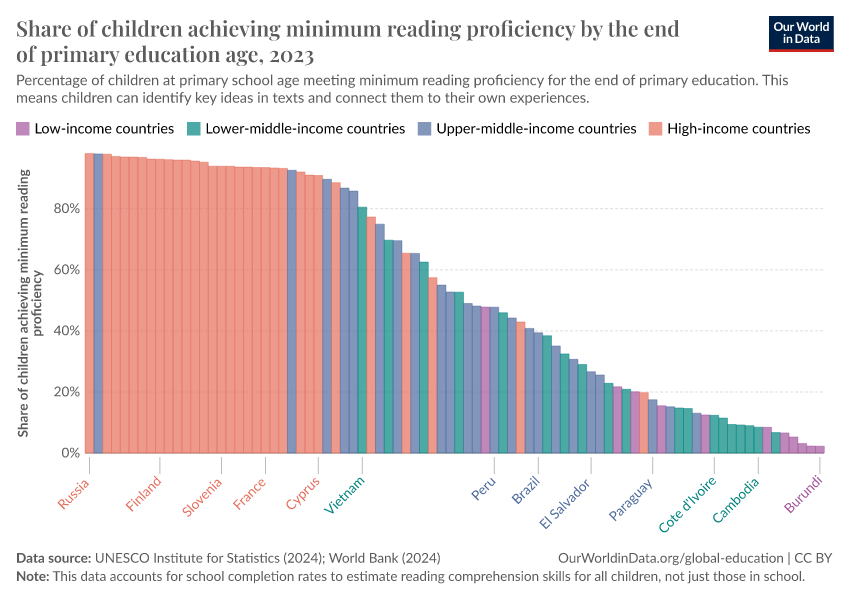
SDG Indicator 4.1.2Ensuring children complete their education
Definition of the SDG indicator: Indicator 4.2.1 is the “completion rate (primary education, lower secondary education, upper secondary education)” in the UN SDG framework.
This indicator is defined as the share of a cohort of children or young adults aged 3-5 years older than the intended age of the last grade of each educational level who have completed that grade.
Shown here in the interactive visualizations is data for this indicator on the national average completion rate for primary education (first chart), lower secondary education (second chart), and upper secondary education (third chart).
Target: By 2030, “ensure that all girls and boys complete free, equitable and quality primary and secondary education leading to relevant and effective learning outcomes.”
More research: Further data and research can be found at Our World in Data topic pages on Education.
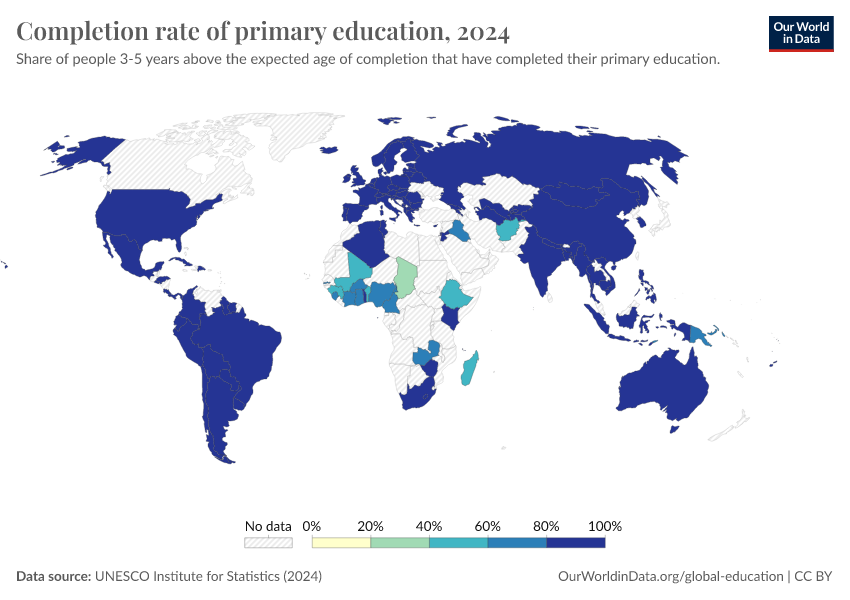
Target 4.2Equal access to quality pre-primary education
SDG Indicator 4.2.1Ensuring children are developmentally on track
Definition of the SDG indicator: Indicator 4.2.1 is the “proportion of children aged 24–59 months (2-5 years) who are developmentally on track in health, learning and psychosocial well-being, by sex” in the UN SDG framework.
Since internationally comparable data for this indicator is not currently available, this is measured by the United Nations through a proxy indicator defined as the proportion of children aged 36-59 months in each country who are developmentally on-track in at least three of the following four domains: literacy-numeracy, physical, socio-emotional and learning.
Data for this indicator is shown in the interactive visualization.
Target: By 2030, “ensure that all girls and boys have access to quality early childhood development, care and pre-primary education so that they are ready for primary education.”
More research: Further data and research can be found at Our World in Data topic page on Education.

SDG Indicator 4.2.2Participation in pre-primary education
Definition of the SDG indicator: Indicator 4.2.2 is the “participation rate in organized learning (one year before the official primary entry age), by sex” in the UN SDG framework.
The participation rate in organized learning is the share of children participating in one or more organized learning programs (including programs that incorporate both education and care) in the year prior to a country’s official entry age.
Data for this indicator is shown in the interactive visualization.
Target: By 2030 “ensure that all girls and boys have access to quality early childhood development, care and pre-primary education so that they are ready for primary education.”
More research: Further data and research can be found at the Our World in Data topic page on Education.
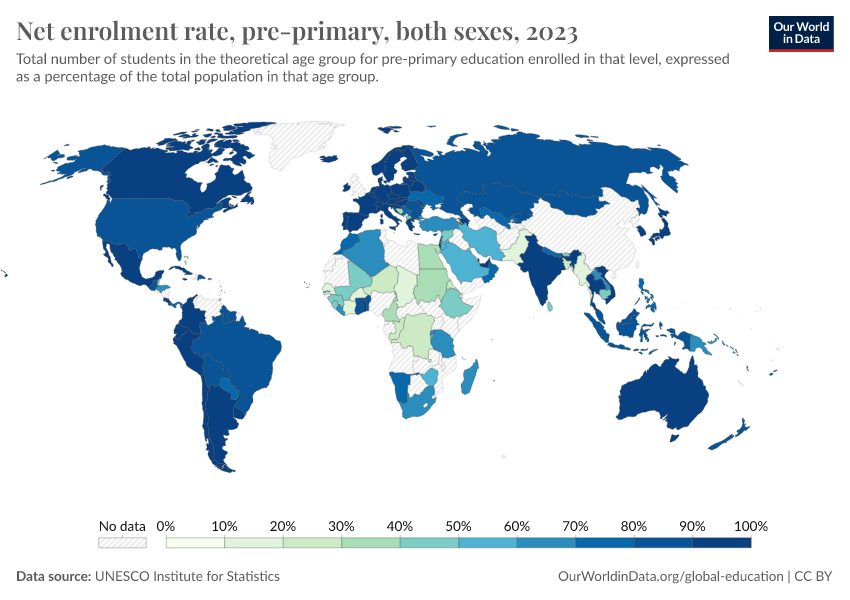
Target 4.3Equal access to affordable technical, vocational and higher education
SDG Indicator 4.3.1Equal access to further education
Definition of the SDG indicator: Indicator 4.3.1 is the “participation rate of youth and adults in formal and non-formal education and training in the previous 12 months, by sex” in the UN SDG framework.
Data for this indicator is shown in the interactive visualization. We also show the enrollment in tertiary education.
Target: By 2030 “ensure equal access for all women and men to affordable and quality technical, vocational and tertiary education, including university.”
More research: Further data and research can be found at Our World in Data topic page on Education.

Target 4.4Increase the number of people with relevant skills for financial success
SDG Indicator 4.4.1Information and communications technology (ICT) skills
Definition of the SDG indicator: Indicator 4.4.1 is the “proportion of youth and adults with information and communications technology (ICT) skills, by type of skill” in the UN SDG framework.
Having a skill in this context refers to having undertaken a certain ICT-related activity in the past three months. This indicator includes multiple ICT skills, including using basic arithmetic formulas in a spreadsheet and verifying the reliability of information found online.
Data for one component of the indicator is shown in the interactive visualizations. The first chart shows the share of youth and adults (aged 15-24 years old) in each country with skills in creating electronic presentations with presentation software. The second chart shows this measure by sex.
Target: By 2030 “substantially increase the number of youth and adults who have relevant skills, including technical and vocational skills, for employment, decent jobs and entrepreneurship.”

Target 4.5Eliminate all discrimination in education
SDG Indicator 4.5.1Disparities in educational access
Definition of the SDG indicator: Indicator 4.5.1 is “parity indices (female/male, rural/urban, bottom/top wealth quintile and others such as disability status, indigenous peoples and conflict-affected, as data become available) for all education indicators on this list that can be disaggregated” in the UN SDG framework.
Parity indices measure the ratio of the value of a measure for one group to the value for another, with the likely more disadvantaged group placed in the numerator.
In the interactive visualizations, data for this indicator is shown for gender parity in primary school completion (first chart), lower secondary school completion (second chart), and upper secondary school completion (third chart).
Target: By 2030 “eliminate gender disparities in education and ensure equal access to all levels of education and vocational training for all.”1
More research: Further data and research can be found at the Our World in Data topic page on Education.
Additional charts
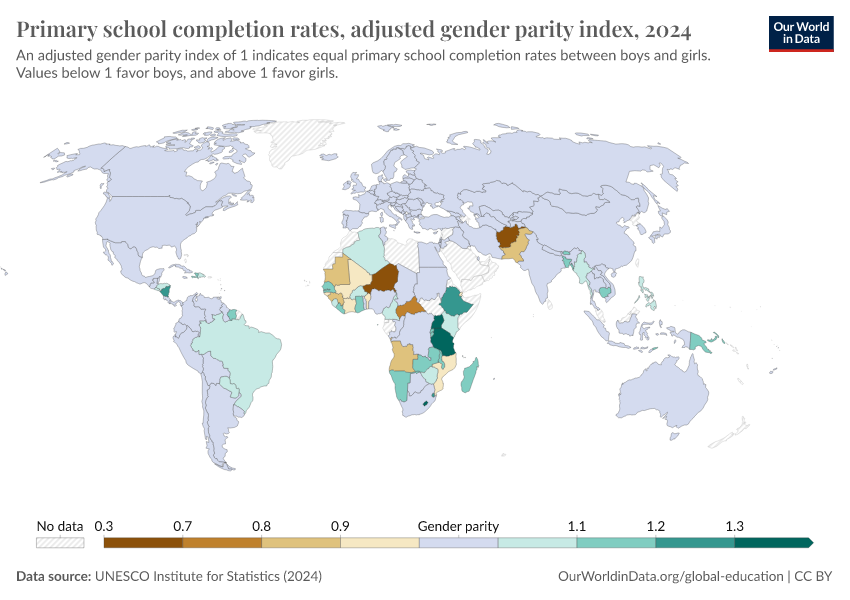
Target 4.6Universal literacy and numeracy
SDG Indicator 4.6.1Universal literacy and numeracy
Definition of the SDG indicator: Indicator 4.6.1 is the “proportion of population in a given age group achieving at least a fixed level of proficiency in functional (a) literacy and (b) numeracy skills, by sex” in the UN SDG framework.
Data for this indicator is shown in the interactive visualizations for young people (first chart), the literacy of adult men and women (second and third chart), and their numeracy (fourth and fifth chart).
Target: By 2030 “ensure that all youth and a substantial proportion of adults, both men and women, achieve literacy and numeracy.”
More research: Further data and research can be found at the Our World in Data topic page on Literacy.
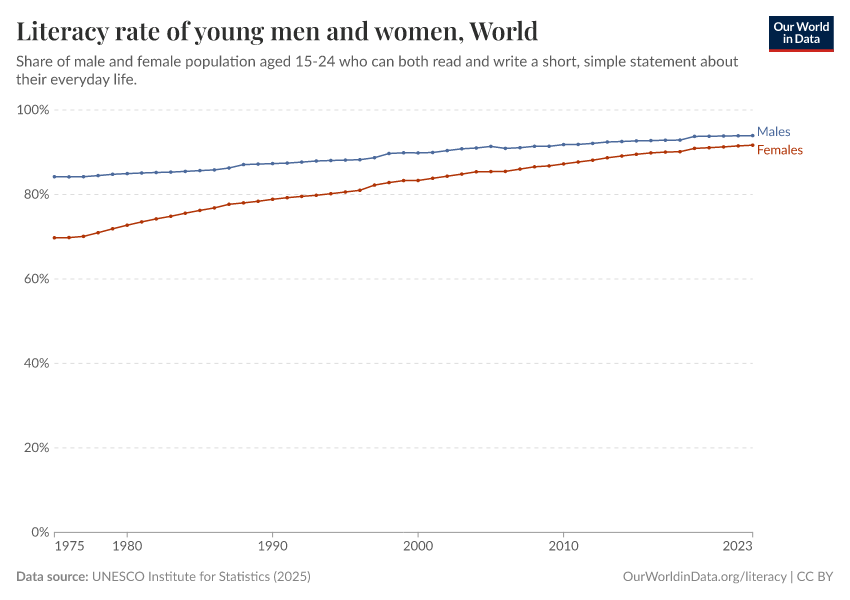
Target 4.7Education for sustainable development and global citizenship
SDG Indicator 4.7.1Education on sustainable development and global citizenship
Definition of the SDG indicator: Indicator 4.7.1 is the “extent to which (i) global citizenship education and (ii) education for sustainable development are mainstreamed in (a) national education policies; (b) curricula; (c) teacher education; and (d) student assessment” in the UN SDG framework.
These measures reflect characteristics of country education systems, as reported by government officials, and measure what governments intend rather than what is implemented in practice. For each component, a score is calculated by combining a number of criteria to give a single score of one to zero.
Data for this indicator is shown in the interactive visualization, including each of the components related to teacher education, curricula, student assessment, and national education policies.
Target: By 2030 “ensure that all learners acquire the knowledge and skills needed to promote sustainable development.”2

Target 4.aBuild and upgrade inclusive and safe schools
SDG Indicator 4.a.1Inclusive and safe schools
Definition of the SDG indicator: Indicator 4.a.1 is the “proportion of schools offering basic services, by type of service” in the UN SDG framework.
Data for this indicator is shown for a variety of basic services, including access to electricity, handwashing facilities, and access to drinking water.
Target: “Build and upgrade education facilities that are child, disability and gender sensitive and provide safe, non-violent, inclusive and effective learning environments for all.”
More research: Further data and research can be found at the Our World in Data topic page on Teachers and Schools.
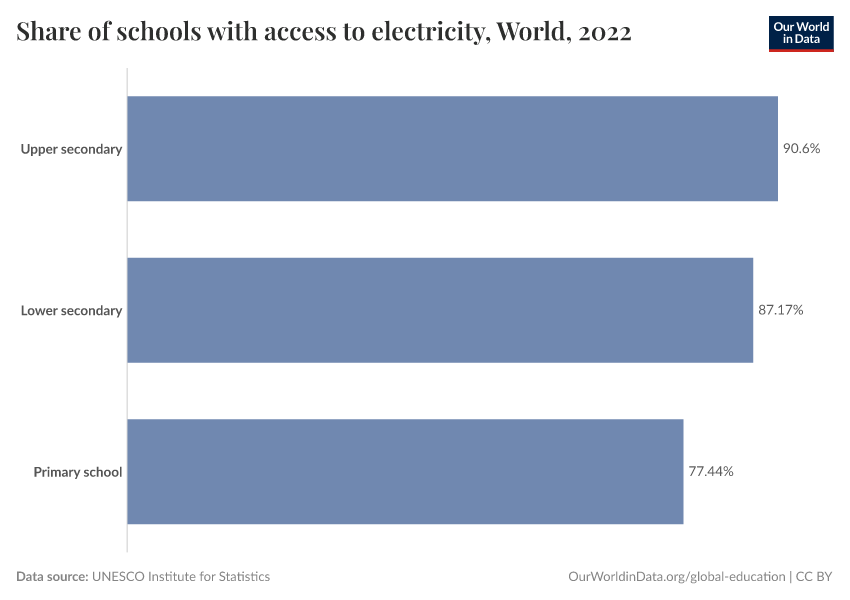
Target 4.bExpand higher education scholarships for developing countries
SDG Indicator 4.b.1Scholarships for developing countries
Definition of the SDG indicator: Indicator 4.b.1 is the “volume of official development assistance flows for scholarships by sector and type of study” in the UN SDG framework.
This indicator is disbursements of official development assistance (ODA) for scholarships, defined as financial aid awards for individual students and contributions to trainees, where students and trainees are nationals of recipient countries.
Official development assistance refers to flows to countries and territories on the Organization for Economic Co-operation and Development’s Development Assistance Committee (DAC) and to multilateral institutions which meet a set of criteria related to the source of the funding, the purpose of the transaction, and the concessional nature of the funding.
Data for this indicator is shown in the interactive visualization.
Target: By 2020 “substantially expand globally the number of scholarships available to developing countries.”3
Unlike most SDG targets which are set to be achieved by 2030, this indicator has a target year of 2020.
More research: Further data and research can be found at Our World in Data topic page on Financing Education.

Target 4.cIncrease the supply of qualified teachers in developing countries
SDG Indicator 4.c.1Supply of qualified teachers
Definition of the SDG indicator: Indicator 4.c.1 is the “proportion of teachers with the minimum required qualifications, by education level” in the UN SDG framework.
This indicator is measured as the share of pre-primary, primary, lower secondary and upper secondary teachers who have received the minimum organized pedagogical teacher training required for teaching at the relevant level in a given country.
Data for this indicator is shown in the interactive visualizations for pre-primary education (first chart), primary education (second chart), lower secondary education (third chart), and upper secondary education (fourth chart).
Target: By 2030 “substantially increase the supply of qualified teachers.”4
More research: Further data and research can be found at Our World in Data topic page on Teachers and Schools.
Additional charts
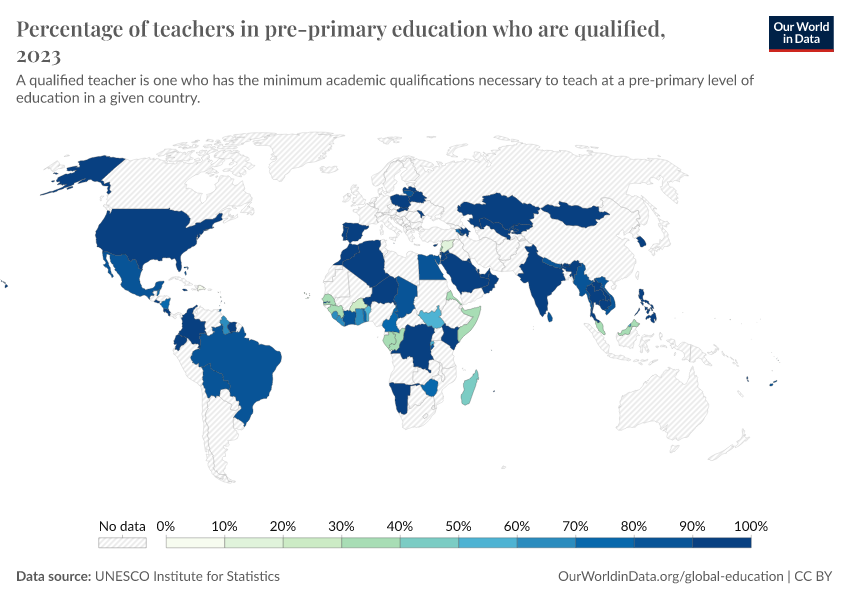
Endnotes
Full text: “By 2030, eliminate gender disparities in education and ensure equal access to all levels of education and vocational training for the vulnerable, including persons with disabilities, indigenous peoples and children in vulnerable situations.”
Full text: “By 2030, ensure that all learners acquire the knowledge and skills needed to promote sustainable development, including, among others, through education for sustainable development and sustainable lifestyles, human rights, gender equality, promotion of a culture of peace and non-violence, global citizenship and appreciation of cultural diversity and of culture’s contribution to sustainable development.”
Full text: “By 2020, substantially expand globally the number of scholarships available to developing countries, in particular least developed countries, small island developing States and African countries, for enrolment in higher education, including vocational training and information and communications technology, technical, engineering and scientific programmes, in developed countries and other developing countries.”
Full text: ”By 2030, substantially increase the supply of qualified teachers, including through international cooperation for teacher training in developing countries, especially least developed countries and small island developing States.”
Cite this work
Our articles and data visualizations rely on work from many different people and organizations. When citing this article, please also cite the underlying data sources. This article can be cited as:
Our World in Data team (2023) - “Ensure inclusive and quality education for all and promote lifelong learning” Published online at OurWorldinData.org. Retrieved from: 'https://archive.ourworldindata.org/20251125-173858/sdgs/quality-education.html' [Online Resource] (archived on November 25, 2025).BibTeX citation
@article{owid-sdgs-quality-education,
author = {Our World in Data team},
title = {Ensure inclusive and quality education for all and promote lifelong learning},
journal = {Our World in Data},
year = {2023},
note = {https://archive.ourworldindata.org/20251125-173858/sdgs/quality-education.html}
}Reuse this work freely
All visualizations, data, and code produced by Our World in Data are completely open access under the Creative Commons BY license. You have the permission to use, distribute, and reproduce these in any medium, provided the source and authors are credited.
The data produced by third parties and made available by Our World in Data is subject to the license terms from the original third-party authors. We will always indicate the original source of the data in our documentation, so you should always check the license of any such third-party data before use and redistribution.
All of our charts can be embedded in any site.